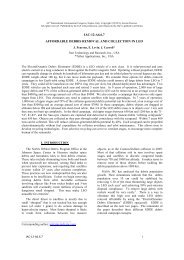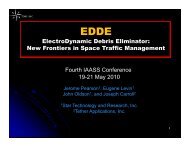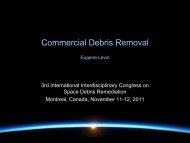The Cost of Future Collisions in LEO - Star Technology and Research
The Cost of Future Collisions in LEO - Star Technology and Research
The Cost of Future Collisions in LEO - Star Technology and Research
You also want an ePaper? Increase the reach of your titles
YUMPU automatically turns print PDFs into web optimized ePapers that Google loves.
22<br />
energy than the splashed solid or liquid. <strong>The</strong> greater mass, speed, <strong>and</strong> the irregular<br />
distribution <strong>of</strong> splashed mass should make it much more effective at shredd<strong>in</strong>g the<br />
parts that missed direct impact. Such shredd<strong>in</strong>g may create substantially more<br />
small shrapnel than other fragmentation mechanisms.<br />
Most <strong>of</strong> the mass <strong>of</strong> both rocket bodies <strong>and</strong> satellites is sheet-like, whether it<br />
is part <strong>of</strong> a tank, rocket eng<strong>in</strong>e, structure, solar array, radiator, circuit board, or<br />
battery. Hypervelocity spray from directly-impact<strong>in</strong>g parts can shred these sheets<br />
<strong>in</strong>to r<strong>and</strong>om sizes down to a few times the sheet thickness. Two- vs many-layer<br />
designs could make rocket shrapnel different from satellite shrapnel. Most such<br />
shrapnel may keep its orig<strong>in</strong>al thickness over much <strong>of</strong> its area, <strong>and</strong> the area-tomass<br />
distribution <strong>of</strong> fragments may be estimated from the bill <strong>of</strong> materials.<br />
Analysis <strong>of</strong> the trajectories <strong>of</strong> tracked fragments shows that they were ejected<br />
from the source objects with velocities <strong>of</strong> a few percent <strong>of</strong> orbital velocity. Collid<strong>in</strong>g<br />
spacecraft are not “bullets <strong>in</strong> foam” or “crossed pitchforks,” <strong>and</strong> the question is why<br />
their fragments departed at relatively low velocities. <strong>The</strong> characteristic velocity may<br />
be determ<strong>in</strong>ed by the shear strength <strong>and</strong> toughness <strong>of</strong> typical aerospace materials.<br />
Shredd<strong>in</strong>g sheet-like materials with hypervelocity sprays need not transfer much<br />
momentum; it simply cuts the sheets, much as a fast-mov<strong>in</strong>g knife can cut an apple<br />
without affect<strong>in</strong>g its trajectory much.<br />
Livermore Laboratory conducted a simulation <strong>of</strong> the Cosmos-Iridium collision<br />
us<strong>in</strong>g a sophisticated hydrodynamic model with close to a million f<strong>in</strong>ite elements per<br />
satellite [12]. This model, however, did not simulate processes on the sub-centimeter<br />
scale <strong>and</strong> could not capture the formation <strong>of</strong> f<strong>in</strong>e hypervelocity sprays. It may not<br />
be practical to extend the model<strong>in</strong>g to a sub-millimeter scale for the entire satellite,<br />
but there is another approach. It is similar to experiments <strong>in</strong> particle accelerators.<br />
If a target few centimeters <strong>in</strong> diameter is hit by a centimeter-size projectile at a<br />
velocity typical for orbital collisions, the formation <strong>of</strong> hypervelocity sprays can be<br />
observed experimentally <strong>and</strong> modeled theoretically down to the sub-millimeter level.<br />
Shredd<strong>in</strong>g by hypervelocity sprays can be observed by plac<strong>in</strong>g typical spacecraft<br />
parts around the target <strong>and</strong> simulated by us<strong>in</strong>g particle penetration models [13].<br />
9. Conclusions<br />
Catastrophic collisions between the large objects <strong>in</strong> <strong>LEO</strong> will produce hundreds <strong>of</strong><br />
thous<strong>and</strong>s <strong>of</strong> debris fragments <strong>in</strong> the centimeter range (“shrapnel”). <strong>The</strong> fragments<br />
<strong>of</strong> these sizes are currently untracked <strong>and</strong> impossible to avoid, but they can disable<br />
or seriously damage operational satellites. Statistically, the fragment yield <strong>of</strong> an<br />
average catastrophic collision will be comparable to the yield <strong>of</strong> the Fengyun-1C<br />
<strong>and</strong> Cosmos–Iridium events comb<strong>in</strong>ed.<br />
To describe future production <strong>and</strong> accumulation <strong>of</strong> small collision fragments,<br />
the concept <strong>of</strong> a virtual stream <strong>of</strong> fragments is <strong>in</strong>troduced. <strong>The</strong> virtual stream is








